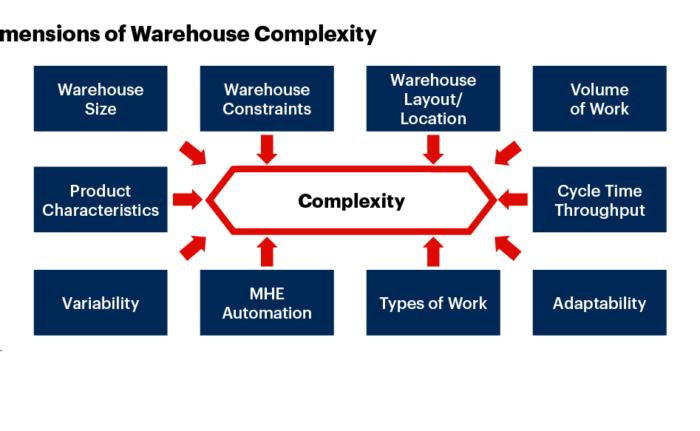You’ve been given the monumental task of finding a new Warehouse Management System (WMS), and you need it fast, but where do you begin? The first step is to slow down. WMS selection is not a process you can rush, it requires research, planning, and a whole lot of thought. Finding the right WMS means finding a system with the functionality you need, from a vendor you can trust, who aligns with your company and can deliver according to your goals.
In an effort to build a comprehensive guide to selecting the right WMS, Made4net asked five industry vanguards to share their tips for success. Each of these individuals has decades of experience in the space, having evaluated, implemented, and managed hundreds of different systems and configurations. They have a rich well of experience to pull from and are happy to guide those who are new to the process. Read on to hear what they have to say about successfully selecting a WMS.
STEP #1: CREATE AN INTERNAL RESOURCE PLAN
Step 1 is all about securing a commitment to the endeavor. To do so, you’ll need to create an internal resource plan and get commitment from the entire business that your WMS project will be staffed accordingly. Delineate all the full-time and part-time resources by department that will be needed for the project. This step is essential. Neglecting it is often what leads to delays and complications down the line. If you doubt that you have the internal resources required, boutique supply chain consulting firms are a great place to look for resources that can augment or even lead your WMS deployment.
A thorough internal resource plan means getting insight from the entire organization including your warehouse team, your IT group, and executive leadership.
• Warehouse managers deal with receiving, inventory, picking, and shipping on a daily basis. They know the strengths and weaknesses of the operations and can pinpoint the manpower needed to implement a new WMS from the operations side.
• Your IT team understands the technical aspect of your operations and will offer vital input on infrastructure requirements and what it will take to get a new WMS up and running from the technical side.
• Your executive team will need to appoint a champion and ensure that the individual has the bandwidth to support the endeavor.
Involving all key stakeholders in the resource planning process allows you to gain an understanding of the total resources required and costs associated with them. Each team will take a different approach to evaluating the need for a new WMS and will want a thorough understanding of the resources associated with procuring and operating a new WMS. Engaging your warehouse team, your IT group, and executive eadership will ensure you don’t miscalculate resource requirements.
“The warehouse team will be extremely important in building the requirements for a WMS vendor evaluation and will push for the needed benefits they desire.”
JEFF CAZA, SUPPLY CHAIN CONSULTANT
Commonwealth Supply Chain Advisors
WITH AN INTERNAL RESOURCE PLAN IN PLACE, YOU ARE READY FOR STEP #2
STEP #2: BUILD A BUSINESS CASE
Developing a Business Case for the WMS project will enable you to establish three critical things:
- Key metrics for measuring results
- The budget needed to cover software and resources (internal and external) for executing the project
- The cost/benefit ratio for the WMS project, meaning how new WMS capabilities will support overall savings and labor efficiencies
As you build your Business Case, keep the big picture in mind. To do so, be sure to prequalify the details internally from three key perspectives: business, operations, and IT. Supply chain needs are always evolving, and everything moves at the speed of light, with acquisitions, new services, and business lines to manage. All these demands will put a strain on your operations, so you’re wise to begin your WMS search with a very broad look at your overall needs and goals.
Interviewing all business, operations, and IT resources will help you understand the bigger picture.
First, you want to gain insight into what the emerging business needs are, like new offerings, verticals, and acquisitions.
This information is then used to give the operations team data to help them determine all functional requirements for a successful implementation.
Finally, the IT team studies those needs and layers in IT requirements to ensure the selected WMS will be consistent with their plans.
“Many companies start with a laser focus on WMS, only to find down the road they need a DOM, LMS, or TMS. Knowing your full needs in advance is better as it’s very difficult to backtrack integrations.”
KEVIN HUME, PROJECT EXECUTIVE
Thruput Partners
WITH YOUR BUSINESS CASE BUILT, YOU ARE READY FOR STEP #3.
STEP #3: DEFINE SPECIFIC REQUIREMENTS
Selecting the right WMS requires a deep understanding of what you need, ambiguity has no place here.
Create an RFX that outlines and matches both your short and long term goals. This means defining all functional requirements, including all traditional WMS functions from inside the warehouse, plus activities related to yard management, dock scheduling, labor reporting, different picking activities, shipment processing activities, etc.
Steven Williams, Project Manager and Senior Systems Consultant for St. Onge Company recommends creating a “Requirements Traceability Matrix” or a spreadsheet of your functional requirements. This requirements matrix will serve as a narrative of your operation. Every detail related to putaway, picking, loading, shipping, etc., should be documented and will show vendors exactly what is needed to create the system that is right for you. This document will essentially allow you to ask the vendor a simple question, “This is what I need. Can you do it?” You will use this requirements matrix as a comparison tool during the vendor selection process in Step #5.
Need help creating your requirements matrix?
There are a variety of pre-written RFP templates available for free online. Use one as a starting point, but customize it for your needs, cutting out anything irrelevant. Don’t bother asking a vendor whether or not their software supports RFID/Serialization if you have no intent on ever deploying those functions! Be sure to add any missing line items that are relevant. You should end up with a document that is succinct and meaningful, that you can use for the next phase.
Thinking Ahead
The cost of your selection will add up over 5-10 years, which means that if something goes wrong, someone at the executive level is going to ask why the system was chosen in the first place. With this matrix, you can prove the decision wasn’t made on a whim, but rather backed by data and research.
Get Outside Help from an Expert
Implementing a new WMS is probably something you will only do once in your career, and it’s a massive undertaking. While you know the ins and outs of your operation like the back of your hand, selecting and implementing a new WMS is likely not your forte, which is why hiring a professional to help with the process is extremely valuable.
“Understanding and documenting your detailed requirements is foundational for all well run WMS projects.”
JOHN SIDELL, CEO AND MANAGING PRINCIPAL
New Course Group
“Consultants are super users in multiple systems. There are a whole slew of steps you need to consider, so bring someone to the table who understands the sequence from vendor selection, system configuration and interface design to identifying super users and training the user base.“
STEVEN WILLIAMS, PROJECT MANAGER & SENIOR SYSTEMS CONSULTANT
St. Onge Company
There will also be a point down the road when the vendor tells you the system is up and running, ready to go, and that they’re moving on to a new customer.
Set yourself up for success by having a consultant available who will be there to assist during the transition phase and support you as other needs arise throughout the years.
WITH YOUR REQUIREMENTS IN HAND, YOU ARE READY FOR STEP #4.
STEP #4: FIND VENDORS
The good news is, there are a bevy of vendors to choose from. The bad news is that there are so many, it’s difficult to know how and where to get started. Do you look at the most recent Gartner Magic Quadrant for the top ranked providers? Poll your contacts on LinkedIn for references? Revisit providers that have served you well in the past? Consider new and upcoming thought leaders who have yet to pursue the challenge of being included in the “magical quadrant”? The answer to all of these questions should be yes!
Exhaust all of your options and take advantage of others’ wins and losses. Begin your search with some general research on 5-8 vendors. Gather information like:
• Do they provide the functionality you need?
• Is the solution configurable to adapt as your business changes?
• What are their licensing costs?
• What are their deployment costs?
• What services are included?
• What timeline can you expect from this kind of project?
This will give you a high level idea of fit, and from there, you can narrow down the list of vendors to engage with.
“I would tell you from experience that if you initially engage more than 5 potential vendors, you are creating a whole bunch of extra work and unnecessary expense.”
GREG UTTER, SENIOR MANAGING DIRECTOR
Alpine Supply Chain Solutions
ONCE YOU’VE NARROWED IN ON THE 3-5 VENDORS YOU ARE GOING TO ENGAGE WITH, YOU ARE READY FOR STEP #5.
“Consider more than just WMS functionality and total price.”
JEFF CAZA, SUPPLY CHAIN CONSULTANT
Commonwealth Supply Chain Advisors
Gauge the Fit
Now is the time to bring out the detailed requirements matrix, or RFX, you created in Step #3. Williams suggests sharing the matrix with vendors so they understand your exact process and requirements. With this matrix and vendor responses in hand, your team can rank vendors on a scale of 1 to 5 for each functional requirement. This allows you to take subjective information and make it objective and measurable, and you’ll be able to assign values to each vendor and begin determining best fit.
Assess Cultural Fit
You’ve probably heard this countless times, and it’s true: a new WMS is a long-term partnership with a software vendor. You need to take this fact into consideration when making your decision. To be sure the vendor you choose is a good fit culturally for your organization, start by asking these questions:
• How competent is their support offering?
• What are their response times?
• How easily can they scale with your business if you decide to add automation or additional sites?
• What is the impact of upgrades and can you take advantage of new functionality in the years ahead?
Make sure the vendor is focused on improving their software in your vertical and market, and that the software will be available for the foreseeable future. The last thing you want to do is spend months implementing a new software, only for it to become obsolete a few years later.
Size Matters
Most of the reputable WMS vendors out there are going to be able to handle all of the basic functionality you need, and most likely they will enable you to improve how you’re performing today. But, many of these vendors will provide more functionality than you need which means you will probably only use about 50% of the available functionality. Having a good understanding of your warehouse complexity is key as more involved facilities require more WMS functional breadth and depth to support their needs, while less complex operations often require less functional robustness. You don’t want to overbuy or underbuy.
Host a Site Visit
Inviting vendors to your site is helpful and should not be too time consuming. A 3-hour visit should suffice; however the exact timing will depend on the complexity of your operation. Site visits serve many purposes:
• They give each vendor a chance to see where their solution will be deployed and enable them to more accurately respond to a sophisticated RFX.
• They enable you to form an initial impression of what is coming, who you’ll be working with, and whether you will work well together.
• They offer complete transparency into your operations and help you eliminate the possibility of ever having to hear a vendor say, “I didn’t know that!” in the future.
To make the most out of the vendor’s visit, be prepared to share information on your operation, like a short video or presentation about your company. You’ll want to include details on what this project represents, its importance, and tentative timelines. Chances are you aren’t the only potential customer they’re bidding, and knowledge of what’s expected early on will help in the event your timeline does not fit into a vendor’s schedule.
“You want each vendor to have the chance to truly visualize your facility and you want your people to meet and greet the vendor representatives who you will be engaged with for a long time.”
GREG UTTER, SENIOR MANAGING DIRECTOR
Alpine Supply Chain Solutions
Request a Demonstration
The RFX you created will come in handy to build the demonstration script. There’s no need to sit through a demonstration that showcases functionality you don’t need. The RFX will easily determine what needs to be included and what can be left out. Greg Utter, Senior Managing Director at Alpine Supply Chain Solutions, recommends one day per demo, using the morning to focus on inbound needs, the afternoon for outbound, and a lunch break in the middle.
Narrow Down the Field of Vendors
After the site visits and demonstrations from potential vendors, it’s time to narrow your selection down to your choices. Once you have selected the vendors you want to move forward with, you can provide them with a final RFX along with the proposed timeline.
Customer Visits
Once you have a few vendors on the shortlist, it’s important to reevaluate them against each other to see who is the best fit. One way to do so is to visit their current customers. This will allow you to get real and honest feedback about the vendor and the solution. Visit no less than one current customer per vendor and make sure from the get-go that the customer you visit is:
• Using the version of software that you are evaluating, hopefully a CURRENT version.
• In an industry or operating environment that closely matches your current/end state goals.
• Able to allow you to evaluate the vendor in ALL regards including software, infrastructure, implementation, pros/cons, and words of advice.
If your vendor has done their homework, you should be seeing an accurate picture of what you will be getting.
Conference Room Pilot
In addition to demonstrations and customer visits, another valuable tactic to assess potential vendors is to invite them to a Conference Room Pilot (CRP). Vendors will usually want to be paid for a CRP, with costs ranging between $10K – $25K.
Steven Williams, Project Manager and Senior Systems Consultant for St. Onge Company, strongly recommends this strategy. He believes that, “Having vendors come in and show you their software running with your data will help you find out if the system is user friendly, if it works as you’ve been told it works, and if all members of your team will find its features and functions useful.”
Contract Early
Starting contract negotiations early on will help you avoid delays in getting your project kicked off. Request contracts as you are making your final decision and have your legal team begin redlines. Many organizations
fail to involve their legal team during the final decision making stage and wind up hitting roadblocks once they are ready to start their WMS project. Working with legal early on may mean you actually get things done ahead of schedule!
FINAL WORDS OF ADVICE…
Best Practices
Remember, when evaluating a WMS, especially during demonstrations, do not try to replicate exactly what you have today. Most WMS software has best practices built into its flows. Look at the suggested processes and understand how they can fit into and improve your warehouse operations rather than trying to customize the software to make it follow the current practices that may be lacking in some places. Sure, there may be a need to customize the software to fit certain aspects of your operations, that’s what makes your business unique. But try to limit that as much as possible, and work towards changing your warehouse operations to fit a WMS’ best practices.
“A new WMS will only be as good as the data it has available. The better the data, the greater the benefit of the WMS, and chances are, if you are searching for a new WMS, your data has been neglected for some time.”
JEFF CAZA, SUPPLY CHAIN CONSULTANT
Commonwealth Supply Chain Advisors
Prepare Your Data
We’ve all heard the saying, “Garbage in, garbage out.” The more accurate your product data is, the more efficient your WMS will operate. Start collecting infor-mation like item dimensions, weights, units per case, and cases per pallet right away. Standardize your location sizes and volumes and clean your customer data. All of this will need to be done before a successful go live, so don’t delay the process. Waiting until implementation time will only delay the project and cause issues during testing.
Selling Up Internally
Making the case for a new WMS system isn’t easy. You need to communicate effectively to showcase the benefits of the project through a Business Case; that’s the only way to realistically position the project.
Unfortunately, trying to sell a project of this scope using functional requirements won’t work, it’s too abstract. Clearly reference specific opportunities and highlight the value each change will bring. You want to break it into digestible chunks of information:
• What we need
• Why we need it
• What is the benefit from both financial and service standpoints
Think about your audience, and cater to them. Giving them financial and service elements that they can at-tribute real value to will help them understand why the project is necessary.
Get it Done Right
Implementing a new WMS takes careful planning, training, testing, and strong leadership throughout the process. The experts who contributed to this paper are happy to serve as resources for any WMS projects you have coming down the pike. We encourage you to reach out to any of them and rest assured that you are in good hands.
MEET THE EXPERTS
Alpine Supply Chain Solutions | Greg Utter, Senior Managing Director
New Course Group | John Sidell, CEO and Managing Principal
St. Onge Company | Steven Williams, Project Manager and Senior Systems Consultant
Commonwealth Supply Chain Advisors | Jeff Caza, Supply Chain Consultant
Thruput Partners | Kevin Hume, Project Executive
Once you’ve selected the best WMS for your business, be sure to check out our complete guide to WMS implementation for a successful deployment.



